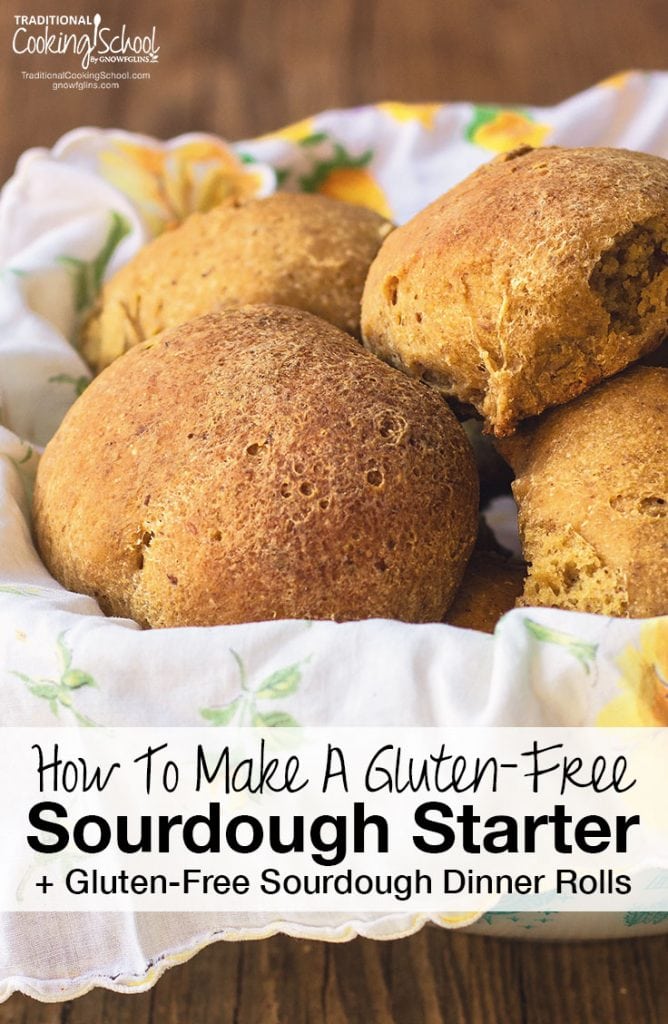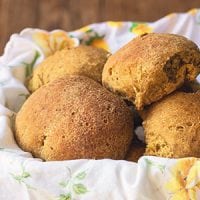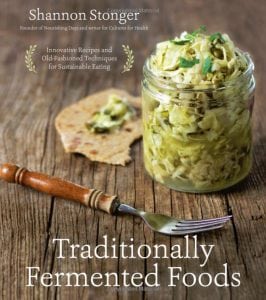
Do you know what you can achieve in as little as 1 week?
A sourdough starter!
And so great bread is born — from simple ingredients like flour and water, bacteria, yeasts, enzymes, and acids. This combination will, quite literally, take your bread to new heights.
How do you make a sourdough starter? Specifically, a gluten-free one?
It’s pretty similar to a traditional wheat, spelt, rye, or einkorn starter. You just substitute teff, sorghum, or buckwheat flour instead. (Other gluten-free flours like tapioca or arrowroot are generally too starchy to make a good starter.)
If cared for properly, your sourdough starter — whether traditional or gluten-free — can last you a lifetime! So let’s begin…
(Not gluten-free? Learn how to make an einkorn sourdough starter in this free video!)
Traditionally Fermented Foods — Now Available
Both the gluten-free sourdough starter instructions and the gluten-free dinner rolls recipe you’ll find in this post come from my good friend (and food chemist) Shannon Stonger of Nourishing Days, from her brand-new, utterly beautiful book Traditionally Fermented Foods.
Shannon’s unpretentious and down-to-earth writing about the beautiful process of fermentation makes it do-able for beginners and oh-so-inspiring for advanced fermenters.
I love all her common sense tips; only someone who has really had their hands in hundreds of ferments, as Shannon has, would know how to explain “when is it done?” (so you know what you’re looking for) and “what’s safe?” (so you can feel confident in what you make).
The recipes and mouth-watering photos from Shannon’s simple homestead make me long for my own garden to be in summer harvest mode all year long.
I can’t wait to make ALL her recipes! This is a book I will pour over again and again for fresh inspiration. A big thumbs up from me!
Traditionally Fermented Foods is available now at Amazon.com or other booksellers. Click here for more info or to buy now!
Thank you, Shannon, for sharing these recipes here!
How To Make A Gluten-Free Sourdough Starter In 1 Week
You will need…
- a quart-sized Mason jar
- 1/2 cup teff, sorghum, or buckwheat flour (62 g)
- scant 1/2 cup water (118 mL)
Days 1 Through 3
Combine flour and water in the quart-sized Mason jar. Mix vigorously to incorporate air. Cover with a clean cloth, paper towel, or coffee filter and secure with a rubber band or canning ring.
Leave at room temperature (65 to 85 degrees Fahrenheit) for 12 hours.
Repeat feedings with 1/2 cup flour and scant 1/2 cup water every 12 hours. During this time, tiny bubbles may form. The starter may start to smell funky or pleasantly sour. Either is fine — forge ahead!
By the 3rd day, you may see more yeast activity, like bubbles and noticeably more starter with a few hours after a feeding.
Days 4 Through 7
Continue to feed every 12 hours. Discard 1/2 of the starter before every feeding.
You should see more yeast activity. The starter may double in volume by 4 to 8 hours after a feeding. In addition to its sour aroma, it should smell slightly yeasty. That’s the microorganisms finding a balance between yeast and bacteria. We want to continue yeast growth by feeding it on a daily basis.
If the starter grows colored molds on top or smells like rotten vegetables, throw it out and start over. This is rare, but you’ll know it when you see it!
Around day 6 or 7, look for an active, bubbly, doubling sourdough starter with a pleasant sour aroma. At this point, bake with it and feed it again. Then either keep up the maintenance feedings, or stick it in the fridge for up to 1 week, or freeze it for later use.
Ready To Get Baking?

Gluten-Free Sourdough Dinner Rolls
Ingredients
- 2 organic or pastured eggs
- 1 cup raw whole milk or dairy-free milk of choice 237 mL
- 1/2 cup pure water 118 mL
- 1/4 cup grass fed butter or coconut oil, melted and cooled (57 mL)
- 1/3 cup raw honey 78 mL
- 1/2 cup gluten-free boosted brown rice sourdough starter 118 mL (see instructions above)
- 2 teaspoons sea salt 10 g
- 1 cup rice flour 125 g
- 1-1/4 cups millet flour 151 g
- 1 cup tapioca flour 125 g
- 2 1/2 tablespoons psyllium husk powder 20 g
- 2 tablespoons ground flaxseed 16 g
Instructions
Souring stage...
-
Combine eggs, milk, water, melted fat, honey, and sourdough starter in a medium bowl.
-
In a separate bowl, whisk together salt, flours, psyllium husk, and ground flaxseed.
-
Add the flour mixture to the liquid mixture and mix together until combined.
-
Using a wooden spoon or the paddle attachment of an electric mixer, beat the dough for an additional 5 minutes to strengthen it and incorporate air.
-
Cover and allow to ferment at room temperature for 6 to 8 hours or overnight. After souring, the dough will have risen by approximately 50%.
Baking stage...
-
Two hours before baking, uncover the fermented dough.
-
Divide it into 12 pieces, working carefully so the dough doesn't deflate too much.
-
Gently form each piece of dough into a rounded dinner roll shape.
-
Cover with plastic wrap or a lightly dampened towel.
-
Allow to rise for 2 hours until the rolls have puffed up slightly.
-
Preheat the oven to 375 degrees Fahrenheit.
-
Once preheated, uncover the rolls and place them in the hot oven.
-
Bake for 20 to 25 minutes or until golden and cooked through.
-
Transfer to a basket and serve warm.
Recipe Notes
- Not gluten-free? Learn how to make an einkorn sourdough starter in this free video!
Helpful Links
- The Book: Traditionally Fermented Foods
- (Video) How To Make An Einkorn Sourdough Starter
- FREE No-Knead Einkorn Artisan Bread Recipe
- Gluten Sensitivity & Sourdough: Is Sourdough Gluten-Free?
- When is a Sourdough Starter Ready for Baking?
- Sourdough Tips, Troubleshooting & Frequently Asked Questions (KYF092, 167)
Have you ever tried gluten-free sourdough?
...without giving up the foods you love or spending all day in the kitchen!

2 free books:
Eat God's Way
Ditch the Standard American Diet, get healthier & happier, and save money on groceries...
We only recommend products and services we wholeheartedly endorse. This post may contain special links through which we earn a small commission if you make a purchase (though your price is the same).



What is the healthiest gluten free flour to use for sourdough? Is sorghum flour better than brown rice flour?
Found this from March.
https://traditionalcookingschool.com/2017/03/08/the-best-healthiest-flours-for-sourdough-aw065/
What Marianne said 🙂
It’s best to use a blend of flour for gluten-free (for best results and performance) and for health it’s best to use as much whole grain (sorghum, brown rice, etc.) and less of the pure starches (potato starch, corn starch, arrowroot, etc.).
I hope this helps!
Will this recipe and those like it interfere with nutrient absorption? I mean, obviously the sorghum and/or buckwheat flour is good to go but what about the millet and tapioca flour. Thank you in advance!
Hi, Aubrey: Millet and tapioca flour are both gluten-free and should not interfere with nutrient absorption. I hope that helps! —Sonya, TCS Customer Success Team
I would like to try this but it seems there is something missing. Where does the yeast come in? Or does just mixing the flour and water create yeast? I had a sourdough starter years ago and I remember feeding it sugar. We called him Herman.
Hi Sandy,
The gluten-free starter that you make is the yeast. You’ll make that first (days 1 – 7) and then use the starter as the natural yeast in your rolls.
This sourdough starter is made without sugar and without gluten. 🙂
~Millie, TCS Customer Success Team
So what Im understanding is the flour that you use along with the water sits and creates bacteria and that essentially becomes the yeast
And then you feed it with the flour.
As I said I had a starter years ago but they had us feed it with sugar and someone gave me the start so I thought it had been started with a packet of yeast. I’ll have to try this.
Sandy,
The yeast is naturally present on most organic material, grapes, apples, wheat, etc, its practically everywhere. The bacteria does not transform into the yeast, it acts as a balance to it and helps the yeast thrive by eating materials in the starter that the yeast do not, and produce the acid which gives it the distinct sourdough smell and taste, yeast is actually a mold.
Instruction #6 in the above recipe starts out “hours before baking, uncover the fermented dough.” How many hours before baking? I am assuming 2 hours from another line of instruction, but as the sentence begins mid-stream– I would like to know for sure. I have a friend that is GF and I believe this recipe would be helpful for her. Thank you for all the work and encouragement you give so many.
Hi Rhoda,
Thank you for letting us know this was missing! It is 2 hours. We’ve updated the post so it’s correct now. 🙂
~Millie, TCS Customer Success Team
I am unable to use ground flaxseed due to a thyroid problem. What could I substitute instead.
Hi, Pamela. You could probably substitute ground chia seeds instead. 🙂
Yes, that’s what I was going to say, Wardee!
can I sub out the psyllium husk? it does not do so well for me.
Can this starter be used in the recipes from your original book? With a diagnosis of celiac we are now GF but I’d like to still make all the great recipes!
Thanks!
HI Amy,
This gluten-free sourdough starter can be used with any gluten-free sourdough recipe.
~Danielle, TCS Customer Success Team
How would you replace eggs in this recipe? I am also vegan. Thank you!
try aquafava (water from cooked or canned beans) – whip it up – fold it in – I haven’t tried it in this recipe, but it works great elsewhere. Good luck!
I use a mixture of kamut, spelt, and buckwheat flour that I grind myself. My starter has gone bad. Could I use this recipe to make starter with the flour blend I use?
Hi, Jenny:
I think your blend would work just fine! If you try it, please let us know how it turns out!
Sonya
TCS Customer Success Team
Is there a substitute for millet flour and psyllium husk power in the gluten free sourdough dinner rolls?
Hi, Jean:
I think you could sub the millet flour with another gluten-free flour, but the psyllium husk powder has special properties that make this recipe work well. I don’t think it can be subbed.
I hope that helps!
Sonya, TCS Customer Success Team
I’m confused. The recipe is for gluten-free sourdough bread rolls, and the instructions for making sourdough say nothing about sweet brown rice starter but the recipe calls for 1/2 c. gluten-free brown rice boosted sourdough starter. When you click on the link, it goes back up to the top to make a GF sourdough starter with teff, sorghum, or buckwheat flour and water. Where does the brown rice come in?
I’m sorry, Joanne. That is confusing! For this recipe, you can use the starter from the instructions above it, which calls for teff, sorghum or buckwheat flour. You can also use a brown rice boosted starter, which Wardee discusses in an episode of Ask Wardee. Here’s a link: https://traditionalcookingschool.com/q-a/askwardee-009-gluten-free-sourdough-starter-basics/
Sonya, Customer Success Team
Hi there,
When you say ”Discard 1/2 of the starter before every feeding” do you mean that I get rid of half of the flour and water that I’ve been mixing together for the past 3 days? I noticed some liquid at the top of the mixture, is that what you mean or is that just water accumulation? Sorry, I’m really new at baking!
Hi, Dominique,
Before you feed your starter, you discard half. Then you feed it. When you go to feed it again, discard half before you feed it, then feed it. You only do this is when you first get your starter going, you won’t need to do this once it is ready to use. 🙂
Here is an #AskWardee on this: https://traditionalcookingschool.com/q-a/discard-half-my-starter-at-each-feeding-aw113/
~Peggy, TCS Customer Success Team
Hello! So ive never made a sourdough starter before but really want to make one. So If i do buckwheat flour and water would i need to use any other ingredients with it? I saw you posted something about adding other flours. Also I found your site from farm house on boone, she posted a link to your page about gluten free sourdough
Hi Roxanne,
It’s best to use a blend of flour for gluten-free (for best results and performance) and for health it’s best to use as much whole grain (sorghum, brown rice, etc.) and less of the pure starches (potato starch, corn starch, arrowroot, etc.).
I hope this helps! ~ Vicki, TCS Customer Success Team
Another question i have. On farmhouse on boone she discards hers on the 2nd day does it really matter what day you start discarding? And can I let it sit on counter everyday as long as i feed it?
Hi Roxanne,
It really doesn’t matter when you start discarding but as long as it sooner rather than later. That way you’re working with a smaller amount until your starter is going good.
You certainly can leave on the counter as long as you feed it twice a day. 🙂
~ Vicki, TCS Customer Success Team
when i go to make “sourdough bread” can i use Paleo baking flour mix from Bobs red mill then add my sour starter in with it when ready to make bread. The starter is made from 1/4 cup buckwheat and 1/4 cup water.
Hi Roxanne,
You can use any gluten free flour blend when making your bread. 🙂
~ Vicki, TCS Customer Success Team
Hi team,
I have two questions…
Here you mentioned this info
Then either keep up the maintenance feedings, or stick it in the fridge for up to 1 week, or freeze it for later use.
By maintenance feedings do you mean feed every 12 hours? Or something else?
Do you keep it in the cabinet on maintenance or store in fridge and take out when you need to use it?
Hi, Lee Ann.
You can do weekly or daily maintenance feedings. Here’s more information on that: https://traditionalcookingschool.com/food-preparation/sourdough-routine-with-einkorn-aw052/
If you’re not using it, keep it in the refrigerator and take it out to feed and/or use. 🙂
You can use one flour to create and maintain your starter but when baking you should use a variety as gluten-free recipes work much better when a variety of flours are used to achieve texture and taste. 🙂
~Danielle, TCS Customer Success Team
Hi all,
One more question.
You shared this info.
You can use teff, sorghum or buckwheat to make gluten free sourdough.
1. When you are talking about making the sourdough you shared that you can use one of the three flours to make the gluten free sourdough…then else- where you shared that you should use a mix of flours…
A. I believe you mean you can make the sourdough with one of the flours.
or should you use a mix of these flours to make the sourdough?
B. I think you mean should use a mix of flours for the gluten free items
you make with the sourdough…bread rolls etc?
Hi
I’m in Australia and it’s unbearably hot at the moment. Will it still be ok to leave out for the 6/7 days? I feel like the heat will make it mouldy .
Hi, Dawn:
I’m happy to help! As long as you are feeding your starter regularly, it should be fine to leave it out, even in the heat. Just keep an eye on it. 🙂 —Sonya, TCS Customer Success Team
I’ve done a teff sourdough starter and liked it. (the white rice one never worked for me), but teff is expensive to keep going.
You say corn starch won’t work, but what about cornmeal flour (Aunt Jemina’s cornmeal) or even harina masa? These are finely ground and they still have some protein and nutrients in.
Hi, Jen.
You could try. We really don’t know if it will work or not.
If you try let us know how it turns out.
~Danielle, TCS Customer Success Team
My friend gave me a little bit of GF sourdough starter. I’m totally new to this. What’s my next step? Do I need to “feed” it a few days before I’m ready to bake something?
Hi Trish, it’s great to have friends that share! 🙂
If the starter your friend gave you is mature, you will need to continue with maintenance feedings. Check out the article above for Days 4 – 7 particularly where it talks about days 6-7: At this point, bake with it and feed it again. Then either keep up the maintenance feedings, or stick it in the fridge for up to 1 week, or freeze it for later use.
~ Vicki, TCS Customer Success Team
I’m wondering if you have any experience with the GF starters and the scrap or scrapings method? I HATE throwing away starter, but I usually don’t have time to do something productive with it. If I could combine a GF starter and the scrapings methods (just putting the scrapings of the starter back in the fridge and feeding it the amount I need to be able to use 8-12 hours before I want to use it), I would feel like I was ‘wasting’ so much less. As the world starts getting crazier, I become more averse to waste!
Thanks so much. I love you site!!